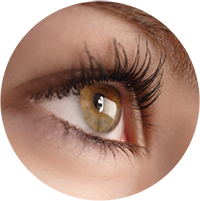Ophthalmic Services
Macular Degeneration

AMD is caused by the natural aging process as tissue within the macula begins to deteriorate. There are other factors that can increase the risk of macular degeneration such as; smoking, high blood pressure, poor diet and obesity.
There are two basic disease patterns for macular degeneration, wet and dry. About 90% of patients will only have early stages or dry macular degeneration. Of those, approximately 10% will go on to become wet AMD in which abnormal blood vessels grow and leak fluids and develop scarring. As these changes occur, the central vision can become distorted, dimmed and color vision can be altered.
New technology and medications have provided treatment options for patients diagnosed with macular degeneration. Please contact us for more information.
YAG LASER TREATMENT
During cataract surgery, your doctor replaces the clouded, blurry area of the lens with an artificial one to correct vision. However, after surgery, many people experience a gradual clouding on the covering of the new lens, a condition known as after cataract or secondary membrane. Clouding is the most common complication of cataract surgery and can cause blurred vision to return, but a solution is available to treat this side effect.
A procedure called a posterior capsulotomy, using an Nd: YAG laser, can be performed to remove the back lining of the lens capsule and let light pass through to the retina. The laser cuts a hole in the back lining and helps remove cloudiness in the lens.
The capsulotomy can be performed in your doctor's office and is a painless procedure that does not require any anesthesia. It is considered a safe procedure and most people only experience short-term increased eye pressure.
A YAG capsulotomy cannot prevent clouding of the lens, but can be beneficial to the 1 in 4 people who experience this complication. It is important to weigh the possible risks and benefits, similar to that of the original cataract surgery, before deciding upon treatment. Most people experience improved vision and reduced glare after undergoing a posterior capsulotomy.
Dry Eye Treatment
Dry eye occurs when the eyes aren't sufficiently moisturized, leading to itching, redness and pain from dry spots on the surface of the eye. The eyes may become dry and irritated because the tear ducts don't produce enough tears, or because the tears themselves have a chemical imbalance.
Non-surgical treatments for dry eye include blinking exercises, increasing humidity at home or work, and use of artificial tears or moisturizing ointment. If these methods fail, small punctal plugs may be inserted in the corners of the eyes to limit tear drainage, or the drainage tubes in the eyes may be surgically closed. Eyelid surgery is also a solution if an eyelid condition is causing your dry eyes.
Corneal Topography
Topography allows your doctor to analyze the shape and contour of the cornea to determine whether or not you are an ideal candidate for laser vision correction or if pathology is present. The topographer measures both the front and back of the cornea for a thorough evaluation of corneal thickness and disease. The cornea shape is measured in just seconds to provide your doctor with immediate results.
Optic Nerve Analysis
The swift and painless optical coherence eye exam can detect the development of glaucoma and retinal disease years earlier than other available technologies. This is made possible by studying damage to the optic nerve, macula and retina before you lose any vision.
During the exam, you simply lean into the optical coherence instrument and look at a light. A harmless laser scans the back of your eye and forms an image in under one second. The entire procedure may be over in less than a minute. It is non-intrusive and does not always require pupil dilation.
Test results are available immediately which supplies your physician with information about the health of your eyes that cannot be obtained from other exams.
For more information about Conditions & Treatments, or to schedule an appointment, please call 247.255.3515.

